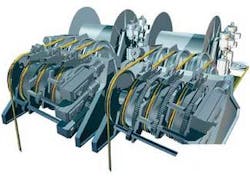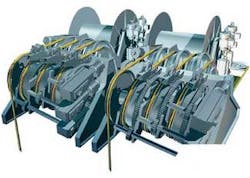New traction control unit extends life of fiber rope
Aker Oilfield Services has awarded Norway’s Odim ASA a contract for a 125-metric-ton (138-ton) cable traction control unit (CTCU). The contract, part of a joint industry project (JIP) supported by Norway’s Demo 2000 research program, opens the way for deliveries of Odim’s CTCU systems to the Aker Oilfield Services newbuild program, which encompasses five vessels in addition to the ship that will receive a CTCU through the JIP.
‘‘This is an important breakthrough for our deepwater technology Odim CTCU and our commitment to the very promising deepwater market,’’ says Jogeir Romestrand, Odim ASA chief executive.
The contract ensures financing for Odim’s fabrication and on-site testing of a system with a two-fall configuration, which would allow companies pursuing demanding deepwater projects to install structures weighing up to 250 metric tons (276 tons). The system is due for delivery in April 2009.
Since the cost to develop a 125-metric-ton (138-ton) lifting system depends on the scope of the necessary additional equipment, the overall cost has yet to be determined. However, Odim estimated a price of about NOK 60 million ($10.6 million) for the CTCU-based system.
The JIP, now being joined by Aker Oilfield Services, is funded partly through the Demo 2000 program, which was established by the Research Council of Norway for project-oriented technology development in the petroleum industry. The JIP has proven effective in generating these kinds of projects.
Benefits of fiber rope
The industry is beginning to realize the benefits of fiber rope. Fiber rope is as strong as steel wire of the same dimension, but only a tenth of the weight in air. While a steel wire dimensioned to lift a 250-metric-ton (276-ton) module up to 2,500 m (8,202 ft) weighs 300 metric tons (330 tons) in water, a fiber rope of the same length is neutral in water for all practical purposes. This means that an equal size lightweight fiber rope can handle a substantially higher payload in deepwater.
With its low specific weight, fiber rope makes it possible to use winches and handling equipment with smaller power requirements and dimensions than the same equipment for steel wire. This not only reduces energy consumption, but also makes it possible to use smaller ships or rigs.
Finally, fiber rope can be spliced and repaired onsite, which is a critical advantage over wire rope, which has to be replaced or repaired onshore.
The advantages of using fiber rope are many, but the rope requires careful handling that is not possible with conventional winches, particularly in deepwater, because fiber rope stretches 2-3% under load.
Now, Odim’s CTCU technology makes it possible to use fiber rope instead of steel wire cables for installation work in deepwater.
CTCU
The recent Aker Oilfield Services award has put Odim in a position to prove the broad application of the CTCU in deepwater operations.
‘‘Our unique handling systems for deepwater enhance operational efficiency for Aker Oilfield Services and fit well with that company’s aggressive strategy,’’ says Romestrand. ‘‘The steady expansion in demand for deepwater technology means this project is perfectly timed. It will further demonstrate the unique qualities of the Odim CTCU technology, with the capacity to lift the heaviest subsea modules in the deepest water. Odim CTCU has proved a very cost-effective solution for developing oil and gas fields in deepwater.”
‘‘The Demo 2000 project in which Aker Oilfield Services decided to participate confirms that the industry embraces the Odim CTCU technology and its capacity,’’ says Per Ingeberg, president of Odim Alitec AS. ‘‘This is a big leap for the installation industry. With a 250-metric-ton (276-ton) lifting capacity, we’re raising Odim CTCU up a step and into a market with great potential both immediately and in the longer term. The installation market is now seeking systems that can handle modules weighing up to 250 metric tons (275.6 tons) in water depths of more than 1,500 m (4,920 ft). Odim CTCU represents the best available solution for such conditions. We see that operators want to secure this core technology in order to have a total solution for the aft deck in the future.’’
The key to the CTCU is a winch system that handles fiber rope and cables in a controlled manner to protect against rapid wear and tear.
With a traditional winch, stretching can cause spinning or slippage between the rope and drum. This generates heat and causes wear that deteriorates the rope and can cause it to break. The CTCU uses individually controlled traction sheaves that move at differing speeds to match the speed of the rope under variable tension to avoid slippage. Active heave compensation built into the control system offsets vessel motion with an accuracy of more than 95%. This means the load suspended below water is unaffected by surface waves and can be installed safely on the seabed.
The control system on the Odim CTCU incorporates the means to measure variable tension, speed, and potential slippage. It automatically adjusts for all indications of problems. The fiber rope is checked and logged for material fatigue every 33 cm (13 in.).
If part of the rope is judged to have reached a specified fatigue limit, the operator is notified, and replacement procedures can be implemented onboard.
Two CTCU systems have been sold as part of complete oceanographic packages. These handle equipment for such tasks as taking bottom samples in waters to 6,000-8,000 m (19,685-26,247 ft) deep.
Odim made its first commercial sale of a fiber rope deployment system (FRDS) based on the CTCU to Subsea 7, which used the system for the first time in 2006 and has carried out 200 installation on the Independence Hub project in the Gulf of Mexico. This FRDS has a lifting capacity of about 50 metric tons (55 tons).
Work has begun on design of a 125-metric-ton (138-ton) FRDS in a two-fall configuration. With this design, the FRDS will be able to install modules weighing up to 250 metric tons (276 tons) in water. Development work on the FRDS also is partly funded through Demo 2000, Odim says.
Semisubmersible application
Semisubmersible rigs usually are the first to be deployed on deepwater fields, often for test drilling. Likely to be the first relevant market for the CTCU, deepwater rigs are expected to increase in number from about 40 to 70 by the year 2010.
These rigs command high day rates, move frequently, and require time and a number of support vessels when mobilizing. So they are expected to be the first with a great need for efficient mooring operations. Mooring is used rather than dynamic positioning to avoid fuel costs and emissions, but mooring solutions generally face capacity constraints, particularly in deepwater. The principal advantage of a conventional mooring system is that it is regarded as an established solution.
Although chain and wire occasionally fail because of fatigue, they still are used widely. “Preset mooring” using polyester as the cable, appears to be increasingly popular in deepwater. Although such operations go a long way toward solving the weight challenges, they are demanding in terms of both time and resources.
One of the principal advantages of a mooring system based on the Odim CTCU is that the lower weight of fiber rope increases the payload on the rig. A conventional mooring system with steel wire and chain has a high specific weight, particularly in deepwater. The only limit on mooring depth with the Odim CTCU is the length of the rope rather than its weight. With a storage capacity of more than 3,000 m (9,842 ft) of mooring cable in the system, a rig would be self-contained for all relevant water depths. Other practical benefits include increased safety with few weight restrictions, the ability to replace sections of the mooring line rather than the whole cable, and improved station keeping if the mooring winches are delivered with a dynamic mooring (active winching) configuration.
New, more stringent regulations that call for increased mooring capacity to withstand storms, lead to demands for more mooring points on the rigs. The Odim CTCU allows second- and third-generation rigs to work in deeper water where the weight gain can be used to upgrade the dimensions of such equipment as the riser system.


